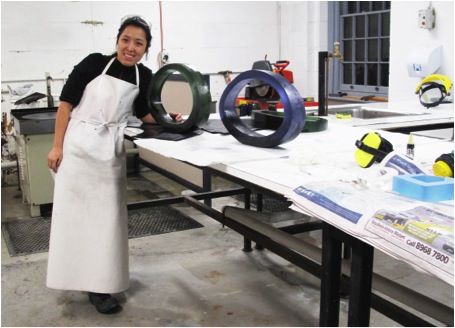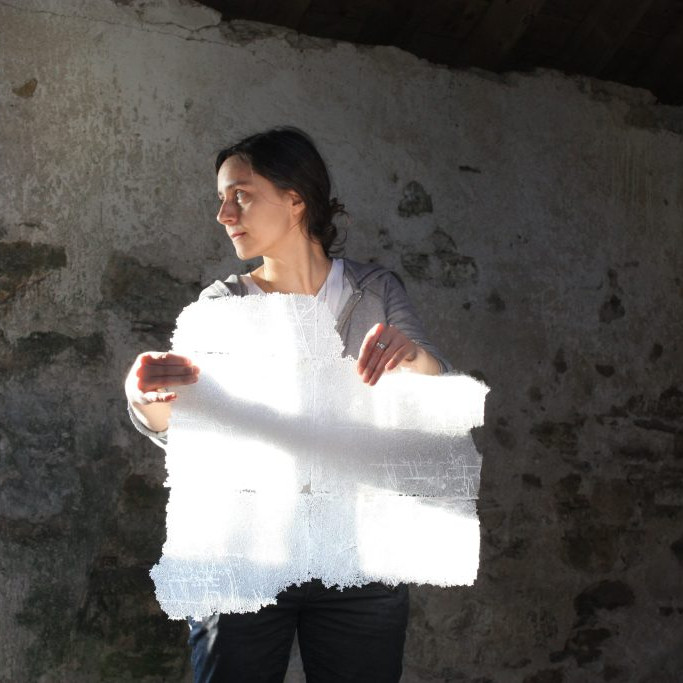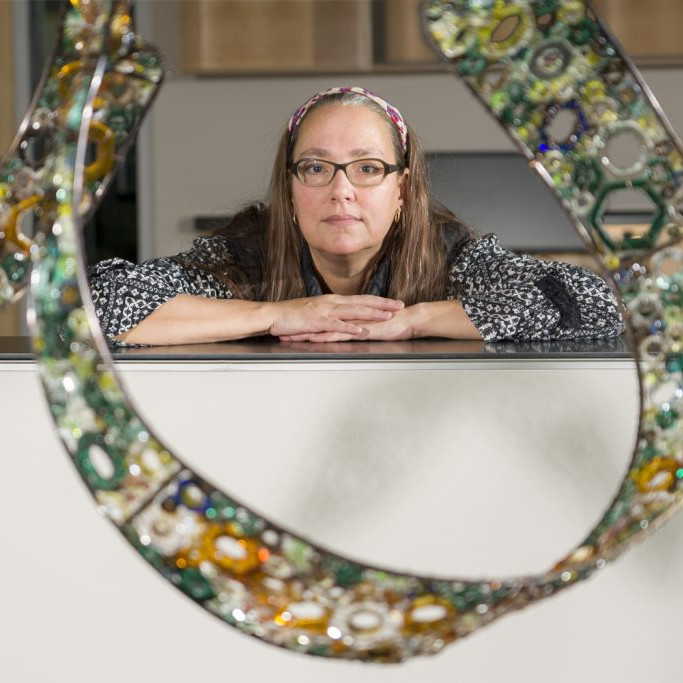Mikyoung Jung Glass Artist - Gyeonggi-do, South Korea
You combine both glass and other metals and materials in your work can you expand on how this came about?
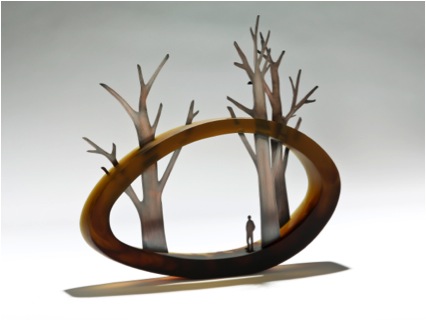
‘Beyond’
As a border-crossing artist, I think my experience of displacement through constant migration has had a profound effect on my art works. My continuing migration from South Korea to Canada, England and Australia as well as living and travelling in different countries as a ‘nomad’ has encouraged me to develop ways to communicate and articulate my feelings beyond the traditional conduit of speech, while also re-defining the boundary between myself and others from different cultures. As I constantly move from place to place, I wanted to explore these spaces that I have visited in the past with colours and appearances by using the material’s fundamental beauty and unique characteristics. While I was seeking my own way to express my observations of the new spaces in which I was residing, I was not reluctant to mix materials even though my art practice has been primarily focused on glass making, particularly kiln-formed glass and casting. Later, I realized the effect my multi- cultural background and previous undergraduate art education in South Korea has had on my current practice. During my B.F.A in South Korea, although my major was in glass, I was fortunate to receive a well-rounded exposure in many different materials such as wood, ceramics, metal, print and mixed media. Thus, it was more natural for me to explore different materials. In my current practice, I mainly use metal and glass. I use metal to emphasize my personal sensory perception of new space in which I am currently residing in or observing, and glass is a great resource that allows me to be able to create boundaries of space in sculptural form with colours. Glass and metal together allow me to be able to create the internal and external space within my practice perfectly. sculptural form with colours. Glass and metal together allow me to be able to create the internal and external space within my practice perfectly.
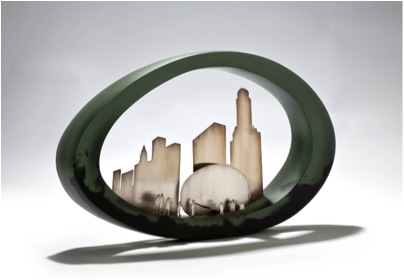
‘In the Shadow of Giants’
Your work is truly 3D, it makes the viewer want to walk around it and view it from all angles. Can you expand on this?
My works are based on real scenery, explored by a creative process through the ‘Journaling’ of my past experiences. Incorporating catalogued data in the form of pictures of experienced landscapes and moments in time, I then start to draw the scenery by using Adobe Illustrator computer software on top of pictures to engage in exploring contemporary human life. I often incorporate metal in my works. Using Adobe Photoshop and Illustrator together before I cut metals, I sometimes collage a few pictures to create the moment as I experienced it.
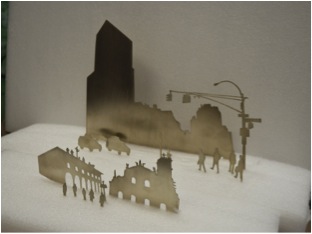
metal placement planning
When I place metal in my work I stagger the pieces that tell my story at different distances on the glass form, so although the metal figures are 2D it appears as a 3D image when it is placed in space. I also modify the size of each metal piece as well as the angle so I can make objects appear larger or smaller depending on distance. The process from planning the placement of the metal to cutting it is honestly quite time consuming and labour intensive I really enjoy doing it. It makes me feel like I am playing with the characters in my story. It possibly feels more real for some people who have shared a similar experience because my works might give them a chance to look at their current reality or look back on a previous experience in their lives and that is the power of my visual ‘journal’.
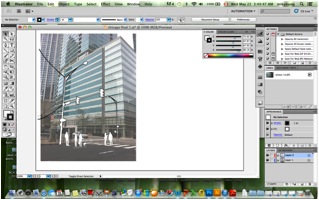
Metal cutting planning with Adobe Illustrator Software
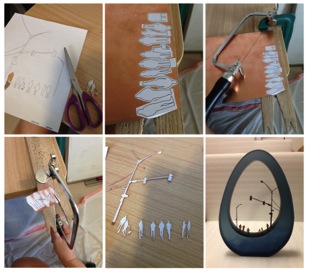
Metal cutting process
Can you discuss the size of your current work?
My current works are in various sizes from small to large. Larger works are approximately 560mm long and 330mm high whereas small works are approximately 350mm long and 190mm high. I send most of my works overseas; I have found it is very difficult to ship works internationally if they are bigger than 600mm. I try to keep the size less than 600mm unless the works are being sent within the country I am currently working in.
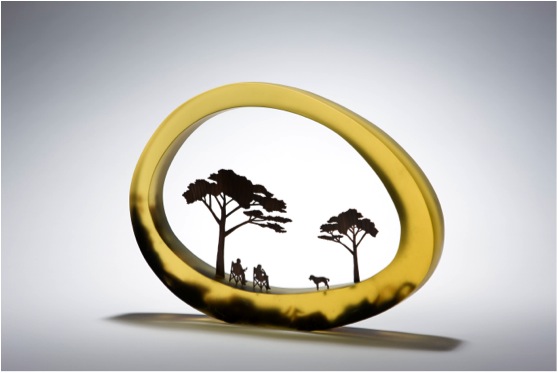
‘A day in the Park’
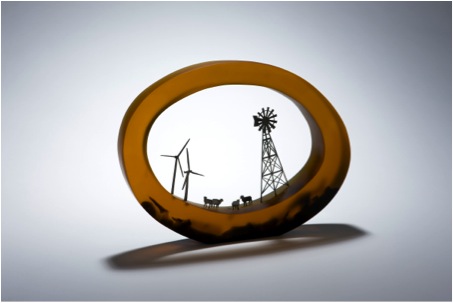
‘Sunrise Sunset’
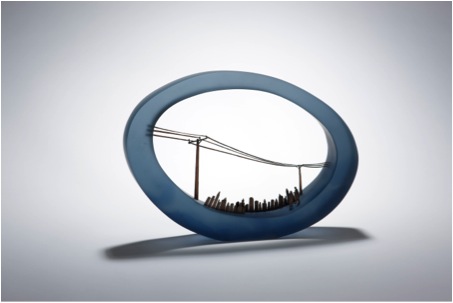
‘City from a distance’
Your comment “the old world and the new, east and west, citizen versus outsider” How is this reflected in your work?
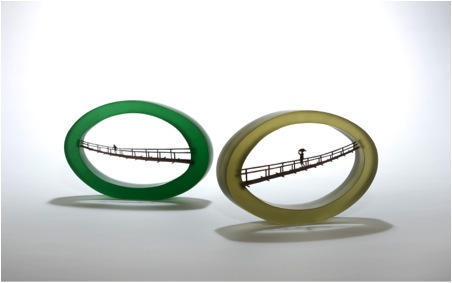
‘Hanging on by a Thread’ and ‘The Daily Commute’
My current work called “Hanging on by a Thread” and “The daily commute” might be a good example in explaining the contrast between citizen and outsider. I recently travelled to the Philippines with my husband and while visiting a small island called Bohol, we came upon a long bridge made from Bamboo connecting one side of a village to another.


At first sight, the bridge seemed fragile and insecure and I was very hesitant to cross. I watched a few travellers cross the bridge visibly nervous. I finally gathered up the courage to cross this bamboo bridge, I noticed a local boy balancing a heavy sack of rice on his head nonchalantly crossing the bridge totally absent of fear from the opposite side. At that moment I realized that two people, albeit from different environments, experiencing the same location in very different ways. Observing the moment as an outsider allowed me to archive this experience into my current work.
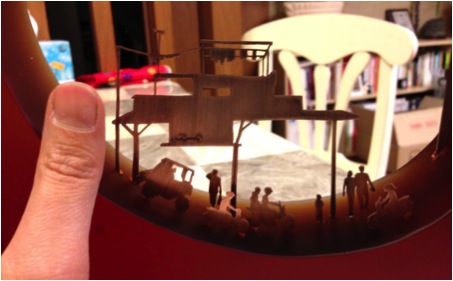
Detail of ‘Unbridled City’
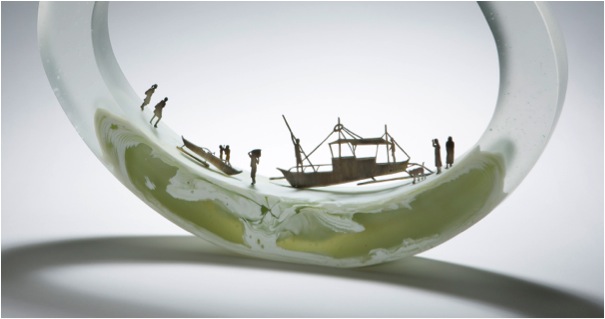
Detail of ‘By the shore’
How has your work altered between the two western locations, Sunderland and Sydney?
The place where I lived in England was the city of Sunderland, located in the north east of England and it was not as multi-cultural as Sydney. It was a difficult time where I felt exposed and like a stranger. Also, at this time I could not yet speak English as well as I can now, so my works were more focused on the differences between ethnicity and language.
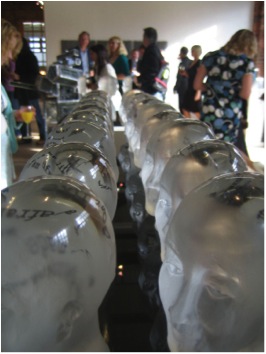
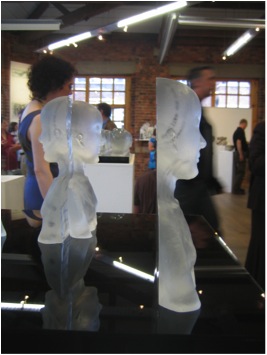
‘Outside and Inside I, II’
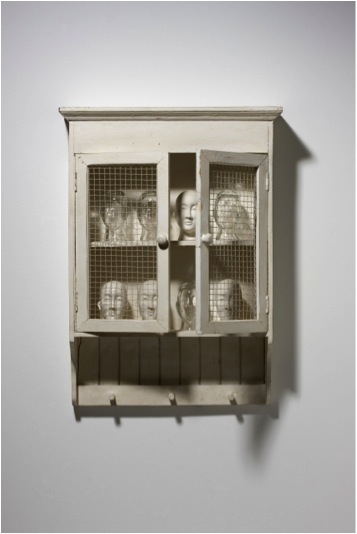
‘As a stranger’
After my studies were completed in England, I came back to South Korea, staying for about two years while sharing a small studio with a former glass artist friend in Seoul . Since Seoul is a very busy densely populated city, I was always surrounded by high buildings and traffic.
When I moved to Sydney, Australia, it was my first time living in a tropical climate and more raw, wild landscape. I was really inspired by the unique animals and flora of Australia’s nature, particularly its variety of vivid colours. I started to makes works which portrayed the different animals, trees, and plants of Australia.
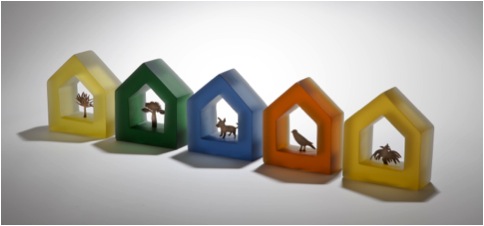
‘Fixture of Suburban life-Urban Jungle’
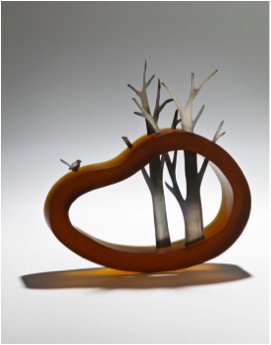
‘View from above’
Can you discuss two pieces of work?
Country landscape
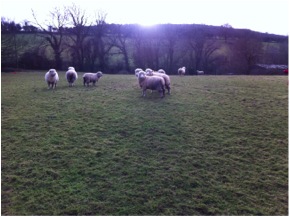
Bristol landscape picture
As I constantly move from place to place travelling to different locations I try to reflect the different landscapes which I have seen from different places into my works. Since I was born and grew up in Seoul, I had always lived in high level apartment blocks surrounded by huge buildings. Therefore, when I travel, especially to the countryside, this inspires me to reflect that moment in my work. One of works that I exhibited at SOFA Chicago last year, called “The pastoral life” was made based on a picture I took while working and travelling in Bristol, United Kingdom.
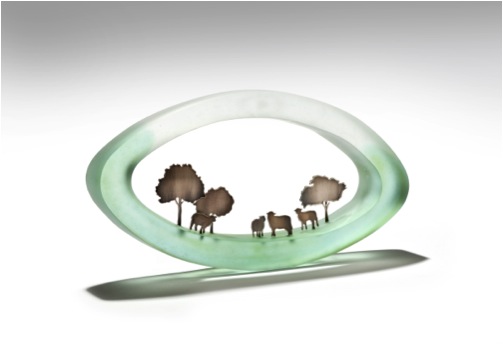
‘The pastoral life’
City landscape
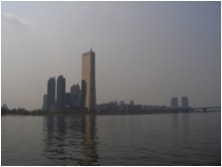
Seoul landscape picture
When I come back home, the scenery which I have witnessed and stored in my mind makes me look at my current reality, that of the city, from a different perspective. The piece called “Ephemeral City” was made just after I returned to Seoul from England and was based on a picture I took on the way back from the airport.
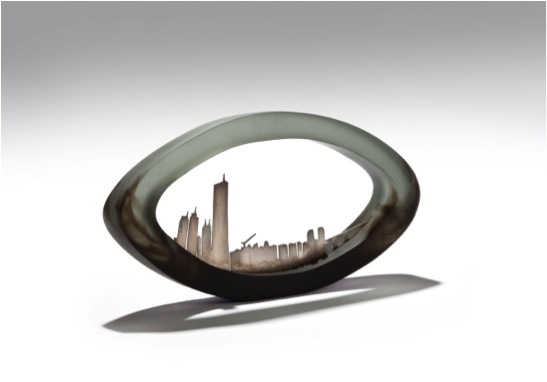
‘Ephemeral City’
Can you discuss the way you choose to colour your glass? Some pieces are completely coloured, others partially coloured while others are clear?
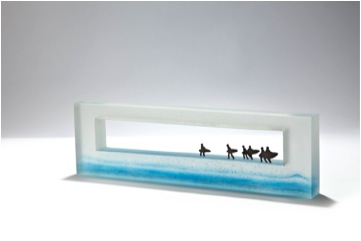
‘On the Coast’
I try to explore works with different colours and incorporate the colours I found in the pictures of a given moment. I think the colour of a moment really brings out my feeling of that moment and reflects my emotions. My choice of colour really depends on the work. Sometimes, works made in one solid colour better reflect the moment. In some of my old works, I built lines with flat coloured glass and stacked them into a mould to create levels in the pieces to create multiple layers to reflect the age of the land and create a layering effect to better illustrate water.
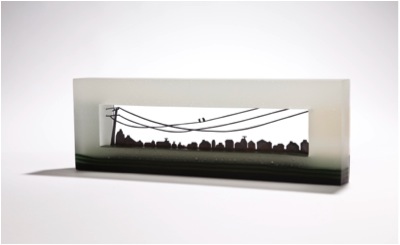
‘The Still City’
Where are you currently exhibiting your work?
My work is currently being exhibited in four locations:
| Melbourne,Australia | Kirra Galleries |
| Pittsburgh, U.S.A | Morgan Contemporary Glass Gallery |
| Denver, U.S.A | Pismo Gallery |
| London, U.K | Zest Gallery |
I have also completed a new work which is going to be exhibited at
The 8th Cheongju International Craft Biennale in Cheongju, South Korea in
August 2013.
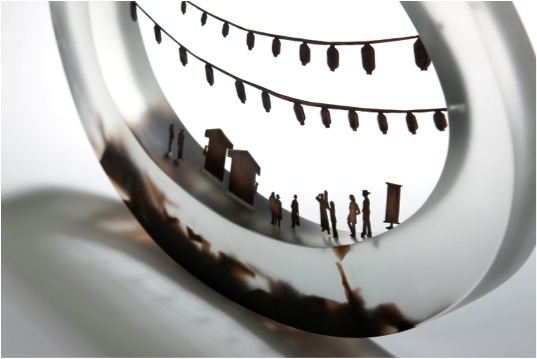
Detail of ‘Old meets New’
Exhibitions are an important aspect for artists; can you explain how you choose where to exhibit?
I try to submit my work to be exhibited in glass art conferences, symposiums, and craft biennales as well as if there is an exhibition where I believe it will allow me to show my work to a wider audience. Besides that, I get calls from galleries asking me to exhibit when they have a group show going on with a certain theme that would suit my work. It really depends on the time.
What are one or two recommendations that you would tell a new artist to keep in mind?
As I learned from my mentor, I think it is very important for an artist to keep informed about information of upcoming competitions and exhibition opportunities in order to be ready to apply for ones that will fit your work. When you apply, having good images of your work will assist you in being selected for these opportunities since for almost all competitions, only images of your work are evaluated in the first round.
Many art students think it will cost too much money to have a professional image, I think it is a worthwhile investment as it brings you good opportunities.
If you use your images well, it really is worth it in the end.
Contact details.
Studio Address:
Joon Glass Studio
824-37 Daeja-dong, Deogyang-gu, Goyang-si, Gyeonggi-do
ZIP:412 480, South Korea
Website: www.mikyoungjung.com
Email: mikyoung.glass@gmail.com
Mikyoung Jung, Gyeonggi-do, South Korea
Interview by Deborah Blakeley, August, 2013
Think a colleague or friend could benefit from this interview?
Knowledge is one of the biggest assets in any business. So why not forward this on to your friends and colleagues so they too can start taking advantage of the insightful information the artist has given?
Other artists you may be interested in:


